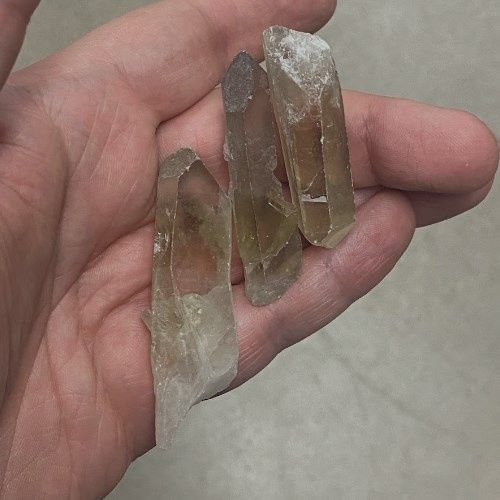Subscribe to our newsletter and get a coupon for 15% off your first order & free shipping!
Citrine Natural Rough Point - Select
SKU 55124
$4.99
Type
Please choose
In stock: 1 available
1
Product Details
Citrine Natural Rough Point - Select
Mineral Information:
Citrine is a yellow or golden variety of quartz, which is a mineral made of silicon dioxide. The color of citrine is due to the presence of iron impurities within the crystal structure. Citrine is commonly found in Brazil, Spain, Russia, France, Madagascar, and the United States.
Citrine is a popular gemstone that is often used in jewelry, and it is also used in metaphysical and spiritual practices. It is known for its bright, sunny energy and is often associated with abundance, prosperity, and success.
Citrine is often heat-treated to enhance its color, and some citrine on the market may actually be heat-treated amethyst or smoky quartz. Natural, untreated citrine is relatively rare and is often more expensive than the heat-treated variety.
Metaphysical Meaning:
Citrine is known as a stone for abundance and prosperity, its warm colors symbolize energy and vitality and as such aid in self-confidence and motivation. It is also an excellent stone for developing joy and optimism. A good stone for developing personal power.
Mineral Care:
Citrine has a hardness of 7 on the Mohs scale, which means it is relatively hard and durable compared to many other gemstones. It is resistant to scratches and abrasions and is less likely to chip or break than softer gemstones like emerald or opal.
However, like all gemstones, citrine can still be damaged if it is subjected to enough force or pressure. It is important to handle citrine with care and avoid exposing it to extreme temperatures, sudden temperature changes, or harsh chemicals that can damage or discolor the stone.
Citrine can also be affected by sunlight, as prolonged exposure can cause the color to fade or change. To preserve the beauty and integrity of citrine, it is recommended to store it in a cool, dry place away from direct sunlight and to clean it gently with a soft cloth and mild soap and water.
Disclaimer:
No information here is intended to diagnose, treat or cure ailments or afflictions of any kind. One should always consult a medical professional if a serious issue presents itself.
Statistics:
Category silicate mineral, quartz variety
Formula (repeating unit) SiO2
IMA symbol Qz
Strunz classification 4.DA.05 (oxides)
Dana classification 75.01.03.01 (tectosilicates)
Crystal system α-quartz: trigonal β-quartz: hexagonal
Crystal class α-quartz: trapezohedral (class 3 2) β-quartz: trapezohedral (class 6 2 2)
Space group α-quartz: P3221 (no. 154) β-quartz: P6222 (no. 180) or P6422 (no. 181)
Unit cell a = 4.9133 Å, c = 5.4053 Å; Z=3
Formula mass 60.083 g·mol−1
Color Yellow, golden or brown (beware the saturated colors of heated amethyst)
Crystal habit 6-sided prism ending in 6-sided pyramid (typical), drusy, fine-grained to microcrystalline, massive
Twinning Common Dauphine law, Brazil law and Japan law
Cleavage {0110} Indistinct
Fracture Conchoidal
Tenacity Brittle
Mohs scale hardness 6.5 - 7
Luster Waxy - Dull
Streak White
Diaphaneity Transparent to nearly opaque
Specific gravity 2.65; variable 2.59–2.63 in impure varieties
Optical properties Uniaxial (+)
Refractive index nω = 1.543–1.545 nε = 1.552–1.554
Birefringence +0.009 (B-G interval)
Pleochroism None
Melting point 1670 °C (β tridymite) 1713 °C (β cristobalite)[3]
Solubility Insoluble at STP; 1 ppmmass at 400 °C and 500 lb/in2 to 2600 ppmmass at 500 °C and 1500 lb/in2[3]
Other characteristics lattice: hexagonal, Piezoelectric, may be triboluminescent, chiral (hence optically active if not racemic)
Save this product for later
Citrine Natural Rough Point - Select
Display prices in:USD

